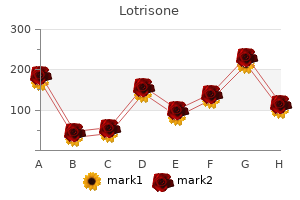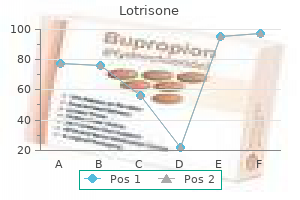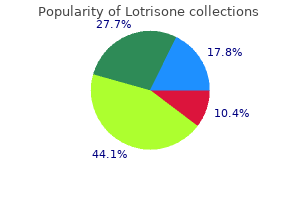"Buy cheap lotrisone 10mg on-line, antifungal nail treatment reviews".
By: Y. Joey, M.A.S., M.D.
Associate Professor, Texas A&M Health Science Center College of Medicine
Perineal lacerations can often be repaired with local anesthetic infiltration or pudendal nerve blocks antifungal rash order 10mg lotrisone. Residual anesthesia from prior epidural or spinal anesthesia facilitates examination of the affected person; nevertheless anti fungal shampoo uk purchase generic lotrisone from india, supplementation with an opioid fungus predator plant prey buy generic lotrisone line, nitrous oxide, or both may be required. Induction of spinal or epidural anesthesia should be avoided within the presence of marked hypovolemia. General anesthesia is often required for handbook extraction of a retained placenta, reversion of an inverted uterus, or repair of a serious laceration. Three parameters are evaluated: baseline coronary heart rate, baseline variability, and the relationship to uterine contractions (deceleration patterns). Baseline Heart Rate the mature fetus normally has a baseline coronary heart rate of 110 to 160 beats/min. An increased baseline coronary heart fee could also be as a outcome of prematurity, gentle fetal hypoxia, chorioamnionitis, maternal fever, maternally administered medication (anticholinergics or -agonists), or, rarely, hyperthyroidism. A decreased baseline heart rate may be because of a postterm pregnancy, fetal coronary heart block, or fetal asphyxia. By 32 weeks, fetuses display periodic will increase in baseline coronary heart fee which may be associated with fetal movements. Normal fetuses have 15 to forty accelerations/h, and the mechanism is believed to involve will increase in catecholamine secretion with decreases in vagal tone. Accelerations diminish with fetal sleep, some medicine (opioids, magnesium, and atropine), in addition to fetal hypoxia. Accelerations to fetal scalp or vibroacoustic stimulation are thought of a reassuring sign of fetal well-being. The absence of both baseline variability and accelerations is nonreassuring and may be an important sign of fetal compromise. Early decelerations are typically not related to fetal misery and occur during descent of the top. Late decelerations may be refined (as few as 5 beats/min) and are thought to represent the impact of decreased arterial oxygen pressure on atrial chemoreceptors. Late decelerations with regular variability may be noticed following acute insults (maternal hypotension or hypoxemia) and are usually reversible with therapy. Late decelerations with decreased variability are related to prolonged asphyxia and may be an indication for fetal scalp sampling (see part on Other Monitoring). Complete abolition of variability in this setting is an ominous signal signifying extreme decompensation and the need for immediate supply. These decelerations are variable in onset, period, and magnitude (often >30 beats/min). Baseline Variability the healthy mature fetus usually shows a baseline beat-to-beat (R-wave to R-wave) variability that can be categorised as minimal (<5 beats/min), moderate (6�25 beats/min), or marked (>25 beats/min). Baseline variability, which is finest assessed with scalp electrodes, has turn out to be an important sign of fetal well-being and represents a normally functioning autonomic system. A sinusoidal sample that resembles a smooth sine wave is related to fetal despair (hypoxia, medicine, and anemia secondary to Rh isoimmunization). Variable decelerations are usually related to fetal asphyxia when fetal heart price declines to less than 60 beats/min, fetal bradycardia lasts more than 60 s, or recurrent bradycardia occurs in a sample that persists for greater than 30 min.

Both lumens of the tube must also be suctioned to exclude excessive secretions or obstruction as an element fungus gnats lemon juice purchase lotrisone with paypal. Recruitment maneuvers on the dependent fungus gnats on peppers safe 10 mg lotrisone, ventilated lung might get rid of atelectasis and improve shunt fungus nail generic lotrisone 10mg without prescription. If potential, pulmonary artery clamp can also be positioned throughout pneumonectomy to remove shunt. In sufferers with persistent obstructive lung illness, one ought to at all times be suspicious of pneumothorax on the dependent, ventilated facet as a cause of severe hypoxemia. This complication requires quick detection and remedy by aborting the surgical procedure, reexpanding the operative lung, and immediately inserting a chest tube within the contralateral chest. Adequate oxygenation can often be maintained for extended intervals, but progressive respiratory acidosis limits using this technique to 10 to 20 min in most sufferers. Arterial Pco2 rises 6 mm Hg within the first minute, followed by a rise of 3 to four mm Hg throughout each subsequent minute. High-frequency positive-pressure ventilation and high-frequency jet air flow have been used throughout thoracic procedures as options to onelung ventilation. Small tidal volumes (<2 mL/kg) enable decreased lung excursion, which can facilitate the surgical procedure but still permit ventilation of each lungs. Unfortunately, mediastinal "bounce"- a to-and-fro movement-often interferes with the surgery. Postoperative supraventricular tachyarrhythmias are widespread and often require immediate therapy. Routine postoperative care ought to embrace semiupright (>30�) positioning, supplemental oxygen (40�50%), incentive spirometry, electrocardiographic and hemodynamic monitoring, a postoperative chest radiograph (to verify correct position of all thoracostomy tube drains and central traces and to affirm growth of both lung fields), and adequate analgesia. Inadequate pain control in these high-risk sufferers will result in splinting, poor respiratory effort, and the lack to cough and clear secretions, with an finish result of airway closure, atelectasis, shunting, and hypoxemia. Irrespective of the modality used, there must be a complete plan for ache management. A balance between comfort and respiratory melancholy in sufferers with marginal lung operate is difficult to achieve with parenteral opioids alone. In the absence of an epidural catheter, intercostal or paravertebral nerve blocks with longacting native anesthetics could facilitate extubation and contribute to postoperative analgesia, however have a restricted period of motion, so extra technique of pain administration must be employed. Alternatives to epidural, intercostal, or paravertebral techniques embrace infusion of native anesthetic by way of a catheter positioned in the surgical wound during closure or injection of liposomal bupivacaine into the wound, which will markedly reduce the requirement for parenteral opioids and improve the general quality of analgesia relative to parenteral opioids alone. Epidural analgesia provides glorious ache relief and steady remedy and avoids unwanted aspect effects three. Postoperative Management General Care Most patients are extubated shortly after surgical procedure to lower the danger of pulmonary barotrauma (particularly "blowout" [rupture] of the bronchial suture line). All patients (and especially these with marginal pulmonary reserve) should stay intubated until standard extubation criteria are met. When postoperative mechanical air flow shall be required, double-lumen tubes must be replaced with a daily single-lumen tube at the finish of surgical procedure. We routinely use a catheter guide ("tube exchanger") for this purpose and always use this method when the unique laryngoscopy was tough. Patients are noticed within the postanesthesia care unit, and, in most instances, at least in a single day in a monitored or intensive care unit. Atelectasis and shallow respiratory ("splinting") from incisional pain generally result in hypoxemia and respiratory acidosis. Gravity-dependent transudation of fluid into the intraoperative dependent lung may be contributory. On the other hand, epidural strategies require around-the-clock attention from the acute pain group throughout the infusion and topic the patient to the long record of epidural-related unwanted facet effects and problems Most practitioners use a mixture of opioid (fentanyl, morphine, hydromorphone) and local anesthetic (bupivacaine or ropivacaine), with the epidural catheter placed at a thoracic degree.

Patients with decreased compliance tend to mycelium fungus definition purchase lotrisone 10mg overnight delivery have fast fungus zombie buy 10mg lotrisone visa, shallow breaths treatment for fungus gnats purchase cheap lotrisone line, whereas those with increased airflow resistance have a slow, deep respiratory sample. Effects of Anesthesia on Pulmonary Mechanics the effects of anesthesia on respiratory are complex and relate to changes each in position and anesthetic agent. The mechanisms could additionally be extra advanced; for instance, solely the dependent (dorsal) part of the diaphragm in the supine position strikes cephalad. The larger position of the dorsal diaphragm and 6 Changes in lung mechanics because of common modifications in the thoracic cavity itself decrease lung volumes. Inhalation brokers generally produce speedy, shallow breaths, whereas nitrous�opioid techniques end in slow, deep breaths. Ventilation Ventilation is often measured because the sum of all exhaled fuel volumes in 1 min (minute ventilation, or V). Minute air flow = Respiratory price � Tidal quantity For the common adult at relaxation, minute ventilation is about 5 L/min. Not the entire impressed gas combination reaches alveoli; a few of it remains in the airways and is exhaled with out being exchanged with alveolar gases. The part of the Vt not taking part in alveolar fuel change is identified as useless house (Vd). At end-expiration, the dorsal portion of the diaphragm is extra cephalad and the ventral portion is more caudal than when awake, the thoracic backbone is extra lordotic, and the rib cage strikes inward, all secondary to lack of motor tone. Increased airway resistance is extra generally due to pathological elements (posterior displacement of the tongue; laryngospasm; bronchoconstriction; or secretions, blood, or tumor in the airway) or tools problems (small tracheal tubes or connectors, malfunction of valves, or obstruction of the respiratory circuit). Effects on the Work of Breathing Increases within the work of breathing beneath anesthesia are most often secondary to decreased lung and chest wall compliance and, much less generally, increases in airway resistance (see earlier discussion). The issues of increased work of respiration are normally circumvented by controlled mechanical ventilation. In the upright place, lifeless area is often about a hundred and fifty mL for many adults (approximately 2 mL/kg) and is nearly all anatomic. The weight of an individual in pounds is roughly equivalent to dead area in milliliters. Because Vt within the common adult is roughly 450 mL (6 mL/kg), Vd/Vt is often 33%. Factor Posture Upright Supine Position of airway Neck extension Neck flexion Age Artificial airway Positive-pressure air flow Drugs-anticholinergic Pulmonary perfusion Pulmonary emboli Hypotension Pulmonary vascular illness Emphysema Effect Distribution of Ventilation Regardless of physique place, alveolar ventilation is erratically distributed in the lungs. The right lung receives more air flow than the left lung (53% vs 47%), and the decrease (dependent) areas of both lungs are inclined to be higher ventilated than do the upper areas due to a gravitationally induced gradient in intrapleural strain (transpulmonary pressure). Pleural strain decreases about 1 cm H2O (becomes much less negative) per 3-cm decrease in lung height. In contrast, the smaller alveoli in dependent areas have a lower transpulmonary pressure, are more compliant, and undergo greater expansion throughout inspiration. Airway resistance can also contribute to regional variations in pulmonary air flow. Final alveolar inspiratory volume is solely depending on compliance only if inspiratory time is limitless. In actuality, inspiratory time is essentially restricted by the respiratory fee and the time essential for expiration; consequently, an excessively quick inspiratory time will prevent alveoli from reaching the expected change in quantity. Therefore, even with a standard inspiratory time, abnormalities in either compliance or resistance can stop complete alveolar filling. Time Constants Lung inflation may be described mathematically by the point fixed. Variations in time constants inside the regular lung may be demonstrated in regular people breathing spontaneously throughout abnormally high respiratory rates.

Pediatric neuraxial blocks antifungal herbs buy genuine lotrisone on-line, particularly caudal and epidural blocks antifungal wipes for dogs trusted 10mg lotrisone, are usually performed beneath general anesthesia fungus king twom buy lotrisone 10mg line. Technical Considerations Neuraxial blocks must be performed only in a facility during which all of the equipment and medicines needed for intubation, resuscitation, and basic anesthesia are instantly available. Note the target space (interlaminar foramen) for neuraxial blocks will increase in measurement with flexion. Patients lie on their side with their knees flexed and pulled high against the abdomen or chest, assuming a "fetal position. The melancholy between the spinous processes of the vertebrae above and beneath the level to be used is palpated; this would be the needle entry website. After the preparation resolution has dried, a pores and skin wheal is raised on the level of the chosen interspace with local anesthetic utilizing a small (25-gauge) needle. Note once more the assistant serving to to present maximal needle will be directed barely cephalad. The needle also feels more firmly implanted within the back (like "an arrow in a goal"). If bone is contacted superficially, a midline needle is likely hitting the decrease spinous course of. As the needle penetrates the ligamentum flavum, an apparent enhance in resistance is encountered. Many clinicians routinely use the paramedian strategy for thoracic epidural puncture. After pores and skin preparation and sterile draping (as beforehand described), the pores and skin wheal for a paramedian method is raised 2 cm lateral to the inferior side of the superior spinous process of the desired stage. Because this approach is lateral to many of the interspinous ligaments and penetrates the paraspinous muscular tissues, the needle may encounter little resistance initially and may not seem to be in agency tissue. If bone is encountered at a shallow depth with the paramedian approach, the needle is likely in touch with the medial part of the lower lamina and must be redirected principally upward and perhaps slightly more laterally. Assessing Level of Blockade With information of the sensory dermatomes (see appendix), the extent of sensory block could be assessed by a blunted needle or a piece of ice. Ultrasound-Guided Neuraxial Blockade Although it has not, as of but, remodeled the practice of neuraxial blockade in the identical manner because it has for different procedures, ultrasound steerage can facilitate neuraxial blockade in sufferers with poorly palpable landmarks. All should have a tightly fitting, removable stylet that fully occludes the lumen to avoid monitoring epithelial cells into the subarachnoid space. Broadly, they can be divided into both sharp (cutting)-tipped or blunt-tipped needles. The introduction of blunt tip (pencil-point) needles has markedly decreased the incidence of postdural puncture headache. A needle that encounters bone at a shallow depth (a) is usually hitting the medial lamina, whereas one which encounters bone deeply (b) is farther lateral from the midline. In basic, the smaller the gauge needle (along with use of a blunt-tipped needle), the decrease will be the incidence of headache. Catheters have to be carefully labeled as being subarachnoid, versus epidural, to avoid the potential for inadvertent dosage. Most essential elements Baricity of anesthetic resolution Position of the patient During injection Immediately after injection Drug dosage Site of injection Other elements Age Cerebrospinal fluid Curvature of the spine Drug volume Intraabdominal pressure Needle direction Patient peak Pregnancy Specific Technique for Spinal Anesthesia the midline or paramedian approaches, with the patient positioned in the lateral decubitus, sitting, or prone positions, can be used for spinal anesthesia. As beforehand discussed, the needle is superior from pores and skin by way of the deeper buildings till two "pops" are felt. The first is penetration of the ligamentum flavum, and the second is penetration of the dura� arachnoid membrane.
Lotrisone 10 mg with amex. How to Make Remedies for Skin Yeast & Fungus : Naturopathic Medicine.

